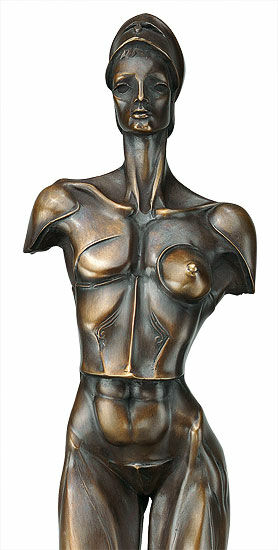Sculpture "Amazon", bronze
Sculpture "Amazon", bronze
Quick info
ars mundi Exclusive Edition | limited, 199 copies | numbered | signed | bronze | handmade | hand-patinated | -polished | total height 54 cm | weight 5.5 kg
Detailed description
Sculpture "Amazon", bronze
Nikolay Anev interpreted the motifs of classical Greek-Thracian mythology with particular passion. He devoted this work to the legendary people of the Amazons. According to the Homeric Iliad, they fought under their queen Penthesilea in the Trojan War. Anev presents his Amazon as a figure armed with helmet and corselet, oscillating between beauty and strength, grace and untouchability.
Exclusive to ars mundi: Sculpture in fine bronze, cast using the Lost-Wax-Process. Patinated by hand, polished and mounted on a diabase pedestal. Limited edition of 199 copies, numbered and signed. Height incl. pedestal 54 cm. Weight 5,5 kg.
About Nikolay Anev
1950-2009, Sculptor
Nikolay Anev, born in in 1950 in Sofia, Bulgaria, was one of the Bulgarian most famous sculptors. In 1984 and 1986, he received national awards for his sculptural oeuvre. He earned his nickname "The Thracian" because, before studying at the Academy in St. Petersburg, he worked as a restorer of Thracian treasures at the National Institute of Cultural Heritage in Sofia. Nikolay Anev died in 2009.
An alloy of copper with other metals (especially with tin) used since ancient times.
When casting bronze, the artist usually applies the lost-wax technique which is dating back more than 5000 years. It's the best, but also the most complex method of producing sculptures.
First, the artist forms a model of his sculpture. It is embedded in a liquid silicone rubber mass. Once the material has solidified, the model is cut out. The liquid wax is poured into the negative mould. After cooling down, the wax cast is removed from the mould, provided with sprues and dipped into ceramic mass. The ceramic mass is hardened in a kiln, whereby the wax flows out (lost mould).
Now we finally have the negative form, into which the 1400° C hot molten bronze is poured. After the bronze had cooled down, the ceramic shell is broken off and the sculpture is revealed.
Now the sprues are removed, the surfaces are polished, patinated and numbered by the artist himself or, to his specifications, by a specialist. Thus, each casting becomes an original work.
For lower-quality bronze castings, the sand casting method is often used which, however, does not achieve the results of a more complex lost-wax technique in terms of surface characteristics and quality.
Graphic or sculpture edition that was initiated by ars mundi and is available only at ars mundi or at distribution partners licensed by ars mundi.
Term for an art object (sculpture, installation), which is produced in multiple copies in a limited and numbered edition according to the artist‘s will.
Artist's multiples have been called the most accessible and affordable art on the market.
A plastic work of sculptural art made of wood, stone, ivory, bronze or other metals.
While sculptures from wood, ivory or stone are made directly from the block of material, in bronze casting a working model is prepared at first. Usually, it is made of clay or other easily mouldable materials.
The prime time of sculpture after the Greek and Roman antiquity was the Renaissance. Impressionism gave a new impulse to the sculptural arts. Contemporary artists such as Jorg Immendorf, Andora, and Markus Lupertz also enriched sculptures with outstanding works.












